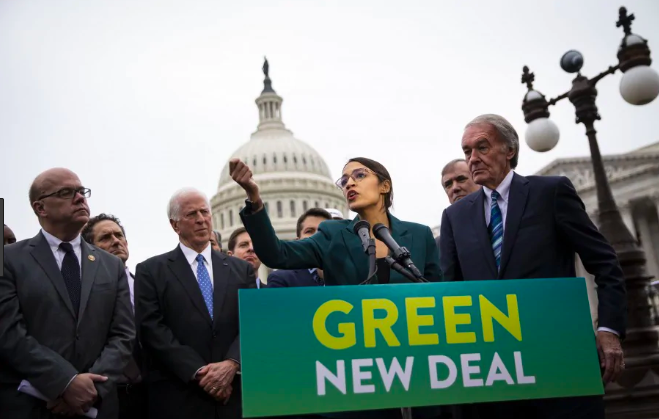The Green New Deal’s Winning Rhetoric for Climate Action
The recent introduction of a resolution supporting a “Green New Deal” by Ed Markey in the Senate and by Alexandria Ocasio-Cortez in the House has been hailed as a crucial development in the national debate over climate change. Not only is it the first signature proposal of Ocasio-Cortez, an ascendant star in the Democratic party, but also the first legislative attempt in nearly a decade to address this existential issue at a national level.
To be sure, this resolution is more of a declaration of sentiments than actual policy, despite being an important consolidation of progressive climate ideas. Its chances of passage, at least in this Congress, are frustratingly nonexistent––and even if it were to pass, more legislative action would be needed to guarantee tangible results. What is significant about the “Green New Deal,” however, is the collaboration of two seemingly disparate rhetorical worlds to advocate transformative action on climate change. It marks the culmination of a decades-long trend towards uniting both economic and moral justifications for action, making a pitch to the American people that focuses just as much on the economic realities that people face as on a moral obligation to saving the planet.
It was once the case that climate-conscious politicians, largely stemming out of the conservationist tradition of the 1960s and ’70s, could and would advocate their positions from a purely moral standpoint. In Richard Nixon’s discussion of his environmental protection policies, he acknowledged the “birthright” of American citizens to a clean environment, and the responsibility of the federal government to protect that environment––not once mentioning the job opportunities and economic security that federal intervention could provide.
This trend continued in the 1990s and early 2000s, as climate change became a mainstream issue for the Democratic Party. Many thought these same moral appeals could be employed in service of pushing legislative action on climate change. The blockbuster success of Al Gore’s film An Inconvenient Truth marked the popular culmination of this approach, convincing policymakers for a brief historical moment that images of melting ice caps and thinning polar bears could, with a Sontagian appeal to painful empathy, inspire real change. But while this effort pushed the conversation forward on climate change as a serious existential problem, purely moral appeals failed to push any legislation over the finish line.
This and other factors show that today’s political circumstances are different from those of fifty years ago: conservation and climate change are now two distinct policy conversations––the latter of which is said to lack the apparent immediacy of the former. But in a broader sense, the shape of our national discourse still suffers in the aftermath of the Reagan era and its prioritization of austerity and harsh individualism over a noble conception of the collective good. For climate change dialogue, this means that the best chance Democrats have at building a winning coalition to address this crisis is to present green climate policies and economic security as they are: interdependent and inseparable. This is what the Green New Deal has the potential to do.
As much as many Americans are apt to support policies they see as protecting the planet for its own sake, many more can also be convinced that this course of action is the right one if policymakers clearly present the economic benefits of action and the inevitable consequences of inaction. For example, a growth in renewable energy production would bring more manufacturing jobs to communities that need them, whereas inaction would cause billions of dollars of damage to the economies of these same vulnerable communities. With the necessity of an outcome that mitigates global warming so urgent to ensure the future health of humans and our planet, support for action must be found wherever, and however, it can be.
This is not at all an unsuccessful strategy. A December opinion poll conducted by climate change communication programs at Yale and George Mason University found that, while most Americans had not yet heard much about the “Green New Deal,” those who had supported its tenets by enormous margins, regardless of political affiliation. It is very possible that as the proposal continues to attract more attention, it will become more recognizably partisan due to media echo chambers and a polarized partisan politics, thereby dividing the public. These early data, however, suggest that talking about job growth and economic opportunity as directly correlative to climate action has just as good a shot as anything to transcend those divisions.
Looking beyond the rhetoric, it is clear to see that the Green New Deal leaves much to be desired in the way of substance and efficacy. A more fully fleshed-out proposal is needed to create a more effective push to get a bill over the finish line. Some of its principal sponsors propose an unsustainable process of ending the legislative filibuster as a means of passing this legislation with a Democratic majority in both houses, increasing the likelihood that Republicans would repeal the measures at the earliest opportunity. Nevertheless, the politics surrounding the “Green New Deal” are a culmination of the strongest public appeals for climate action heard in recent history. It can and ought to serve as a model for the task of all effective climate campaigns––linking the immediate to the existential, the economic to the moral, and the practical to the just.

